technical specifications Alfa Romeo GT 2005 Owner handbook (in English)
[x] Cancel search | Manufacturer: ALFA ROMEO, Model Year: 2005, Model line: GT, Model: Alfa Romeo GT 2005Pages: 307, PDF Size: 6.05 MB
Page 7 of 307
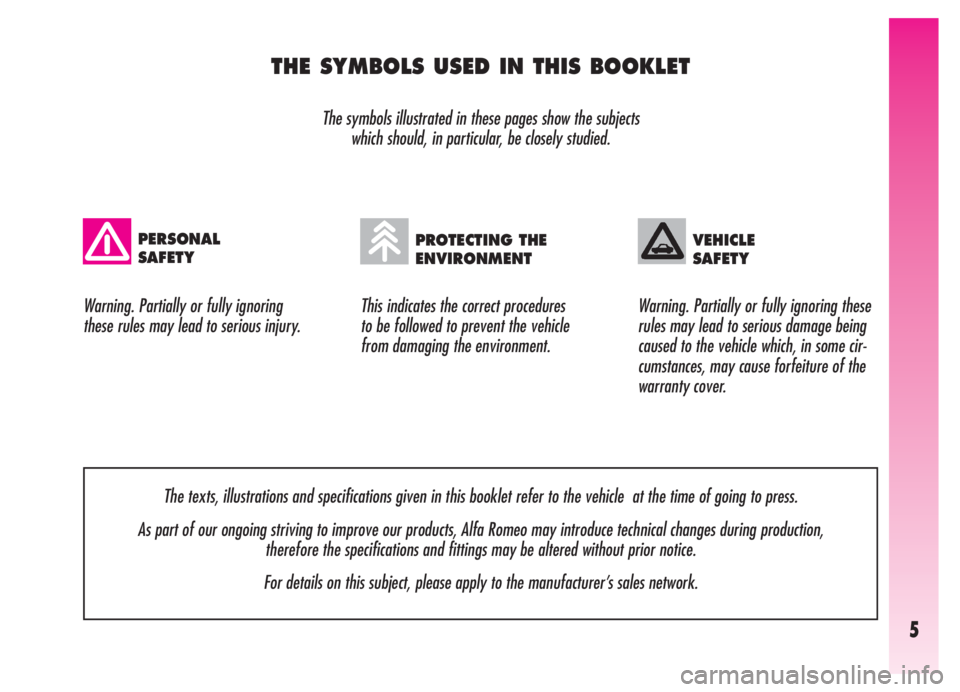
5
THE SYMBOLS USED IN THIS BOOKLET
The symbols illustrated in these pages show the subjects
which should, in particular, be closely studied.
This indicates the correct procedures
to be followed to prevent the vehicle
from damaging the environment. Warning. Partially or fully ignoring
these rules may lead to serious injury.Warning. Partially or fully ignoring these
rules may lead to serious damage being
caused to the vehicle which, in some cir-
cumstances, may cause forfeiture of the
warranty cover.
PERSONAL
SAFETYPROTECTING THE
ENVIRONMENTVEHICLE
SAFETY
The texts, illustrations and specifications given in this booklet refer to the vehicle at the time of going to press.
As part of our ongoing striving to improve our products, Alfa Romeo may introduce technical changes during production,
therefore the specifications and fittings may be altered without prior notice.
For details on this subject, please apply to the manufacturer’s sales network.
Page 210 of 307
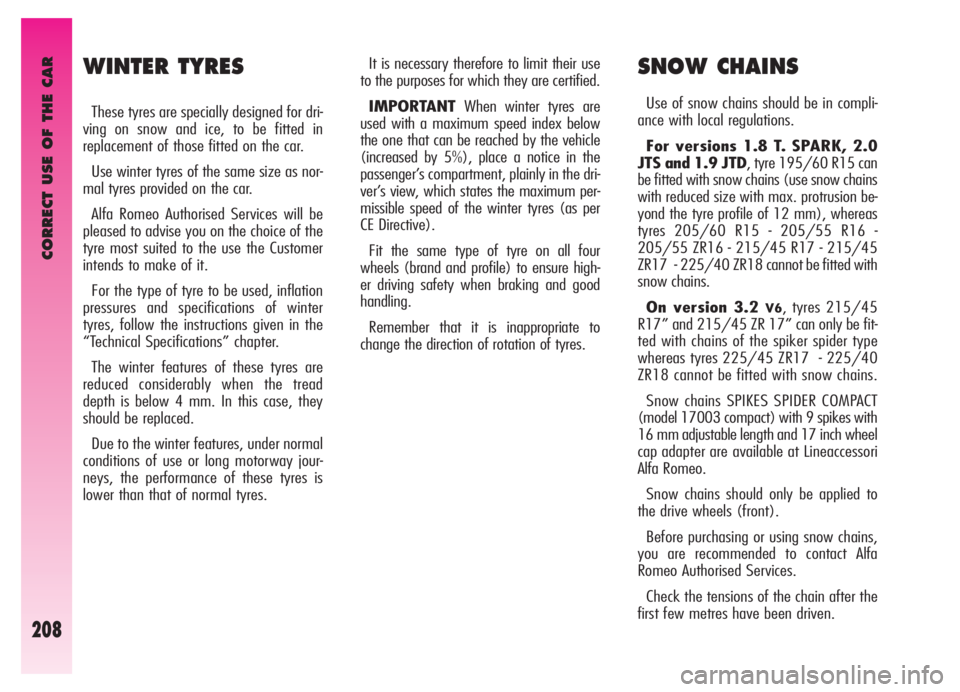
CORRECT USE OF THE CAR
208
It is necessary therefore to limit their use
to the purposes for which they are certified.
IMPORTANTWhen winter tyres are
used with a maximum speed index below
the one that can be reached by the vehicle
(increased by 5%), place a notice in the
passenger’s compartment, plainly in the dri-
ver’s view, which states the maximum per-
missible speed of the winter tyres (as per
CE Directive).
Fit the same type of tyre on all four
wheels (brand and profile) to ensure high-
er driving safety when braking and good
handling.
Remember that it is inappropriate to
change the direction of rotation of tyres. WINTER TYRES
These tyres are specially designed for dri-
ving on snow and ice, to be fitted in
replacement of those fitted on the car.
Use winter tyres of the same size as nor-
mal tyres provided on the car.
Alfa Romeo Authorised Services will be
pleased to advise you on the choice of the
tyre most suited to the use the Customer
intends to make of it.
For the type of tyre to be used, inflation
pressures and specifications of winter
tyres, follow the instructions given in the
“Technical Specifications” chapter.
The winter features of these tyres are
reduced considerably when the tread
depth is below 4 mm. In this case, they
should be replaced.
Due to the winter features, under normal
conditions of use or long motorway jour-
neys, the performance of these tyres is
lower than that of normal tyres.
SNOW CHAINS
Use of snow chains should be in compli-
ance with local regulations.
For versions 1.8 T. SPARK, 2.0
JTS and 1.9 JTD, tyre 195/60 R15 can
be fitted with snow chains (use snow chains
with reduced size with max. protrusion be-
yond the tyre profile of 12 mm), whereas
tyres 205/60 R15 - 205/55 R16 -
205/55 ZR16 - 215/45 R17 - 215/45
ZR17 - 225/40 ZR18 cannot be fitted with
snow chains.
On version 3.2
V6, tyres 215/45
R17” and 215/45 ZR 17” can only be fit-
ted with chains of the spiker spider type
whereas tyres 225/45 ZR17 - 225/40
ZR18 cannot be fitted with snow chains.
Snow chains SPIKES SPIDER COMPACT
(model 17003 compact) with 9 spikes with
16 mm adjustable length and 17 inch wheel
cap adapter are available at Lineaccessori
Alfa Romeo.
Snow chains should only be applied to
the drive wheels (front).
Before purchasing or using snow chains,
you are recommended to contact Alfa
Romeo Authorised Services.
Check the tensions of the chain after the
first few metres have been driven.
Page 215 of 307
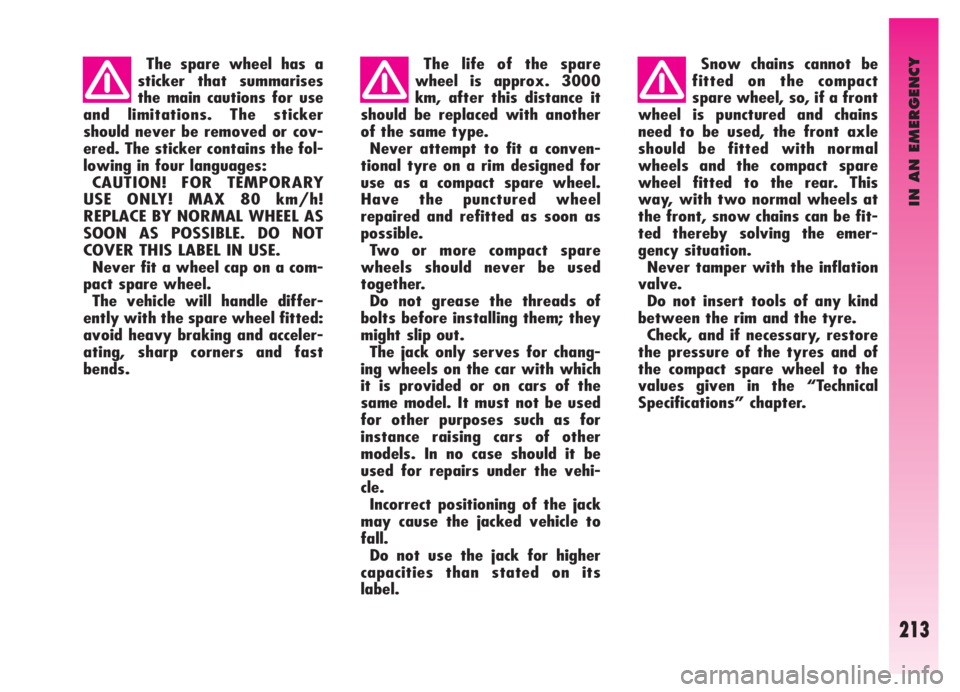
IN AN EMERGENCY
213
The spare wheel has a
sticker that summarises
the main cautions for use
and limitations. The sticker
should never be removed or cov-
ered. The sticker contains the fol-
lowing in four languages:
CAUTION! FOR TEMPORARY
USE ONLY! MAX 80 km/h!
REPLACE BY NORMAL WHEEL AS
SOON AS POSSIBLE. DO NOT
COVER THIS LABEL IN USE.
Never fit a wheel cap on a com-
pact spare wheel.
The vehicle will handle differ-
ently with the spare wheel fitted:
avoid heavy braking and acceler-
ating, sharp corners and fast
bends.The life of the spare
wheel is approx. 3000
km, after this distance it
should be replaced with another
of the same type.
Never attempt to fit a conven-
tional tyre on a rim designed for
use as a compact spare wheel.
Have the punctured wheel
repaired and refitted as soon as
possible.
Two or more compact spare
wheels should never be used
together.
Do not grease the threads of
bolts before installing them; they
might slip out.
The jack only serves for chang-
ing wheels on the car with which
it is provided or on cars of the
same model. It must not be used
for other purposes such as for
instance raising cars of other
models. In no case should it be
used for repairs under the vehi-
cle.
Incorrect positioning of the jack
may cause the jacked vehicle to
fall.
Do not use the jack for higher
capacities than stated on its
label.Snow chains cannot be
fitted on the compact
spare wheel, so, if a front
wheel is punctured and chains
need to be used, the front axle
should be fitted with normal
wheels and the compact spare
wheel fitted to the rear. This
way, with two normal wheels at
the front, snow chains can be fit-
ted thereby solving the emer-
gency situation.
Never tamper with the inflation
valve.
Do not insert tools of any kind
between the rim and the tyre.
Check, and if necessary, restore
the pressure of the tyres and of
the compact spare wheel to the
values given in the “Technical
Specifications” chapter.
Page 252 of 307
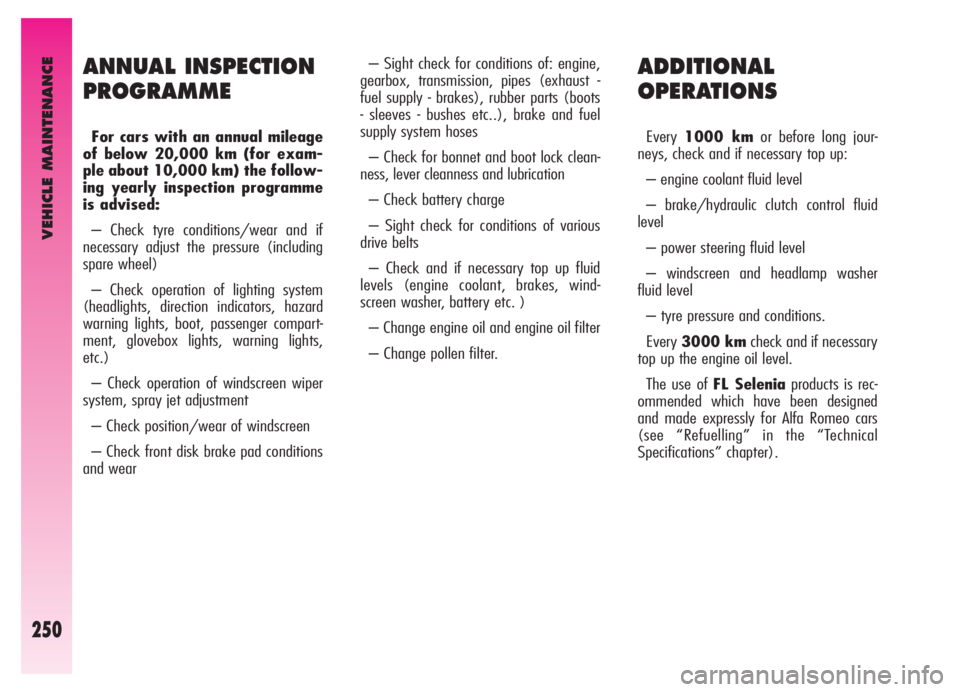
VEHICLE MAINTENANCE
250
ADDITIONAL
OPERATIONS
Every 1000 kmor before long jour-
neys, check and if necessary top up:
– engine coolant fluid level
– brake/hydraulic clutch control fluid
level
– power steering fluid level
– windscreen and headlamp washer
fluid level
– tyre pressure and conditions.
Every 3000 kmcheck and if necessary
top up the engine oil level.
The use of FL Seleniaproducts is rec-
ommended which have been designed
and made expressly for Alfa Romeo cars
(see “Refuelling” in the “Technical
Specifications” chapter).
ANNUAL INSPECTION
PROGRAMME
For cars with an annual mileage
of below 20,000 km (for exam-
ple about 10,000 km) the follow-
ing yearly inspection programme
is advised:
– Check tyre conditions/wear and if
necessary adjust the pressure (including
spare wheel)
– Check operation of lighting system
(headlights, direction indicators, hazard
warning lights, boot, passenger compart-
ment, glovebox lights, warning lights,
etc.)
– Check operation of windscreen wiper
system, spray jet adjustment
– Check position/wear of windscreen
– Check front disk brake pad conditions
and wear– Sight check for conditions of: engine,
gearbox, transmission, pipes (exhaust -
fuel supply - brakes), rubber parts (boots
- sleeves - bushes etc..), brake and fuel
supply system hoses
– Check for bonnet and boot lock clean-
ness, lever cleanness and lubrication
– Check battery charge
– Sight check for conditions of various
drive belts
– Check and if necessary top up fluid
levels (engine coolant, brakes, wind-
screen washer, battery etc. )
– Change engine oil and engine oil filter
– Change pollen filter.
Page 260 of 307
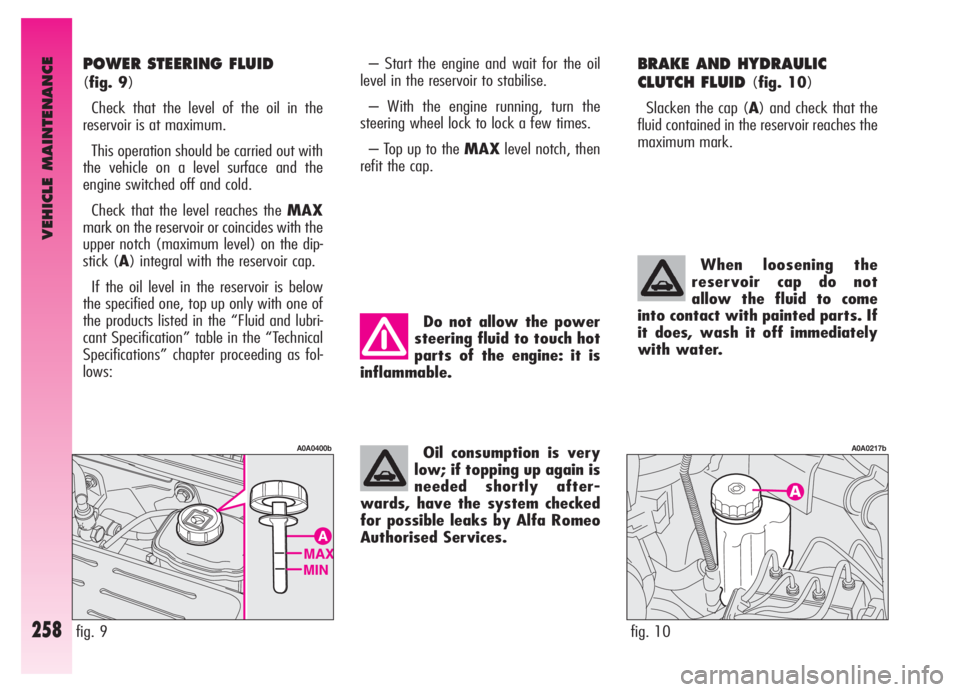
Oil consumption is very
low; if topping up again is
needed shortly after-
wards, have the system checked
for possible leaks by Alfa Romeo
Authorised Services.
VEHICLE MAINTENANCE
258
When loosening the
reservoir cap do not
allow the fluid to come
into contact with painted parts. If
it does, wash it off immediately
with water. Do not allow the power
steering fluid to touch hot
parts of the engine: it is
inflammable.
fig. 10
A0A0217b
fig. 9
A0A0400b
BRAKE AND HYDRAULIC
CLUTCH FLUID
(fig. 10)
Slacken the cap (A) and check that the
fluid contained in the reservoir reaches the
maximum mark.
POWER STEERING FLUID
(fig. 9)
Check that the level of the oil in the
reservoir is at maximum.
This operation should be carried out with
the vehicle on a level surface and the
engine switched off and cold.
Check that the level reaches the MAX
mark on the reservoir or coincides with the
upper notch (maximum level) on the dip-
stick (A) integral with the reservoir cap.
If the oil level in the reservoir is below
the specified one, top up only with one of
the products listed in the “Fluid and lubri-
cant Specification” table in the “Technical
Specifications” chapter proceeding as fol-
lows:– Start the engine and wait for the oil
level in the reservoir to stabilise.
– With the engine running, turn the
steering wheel lock to lock a few times.
– Top up to the MAXlevel notch, then
refit the cap.
Page 266 of 307
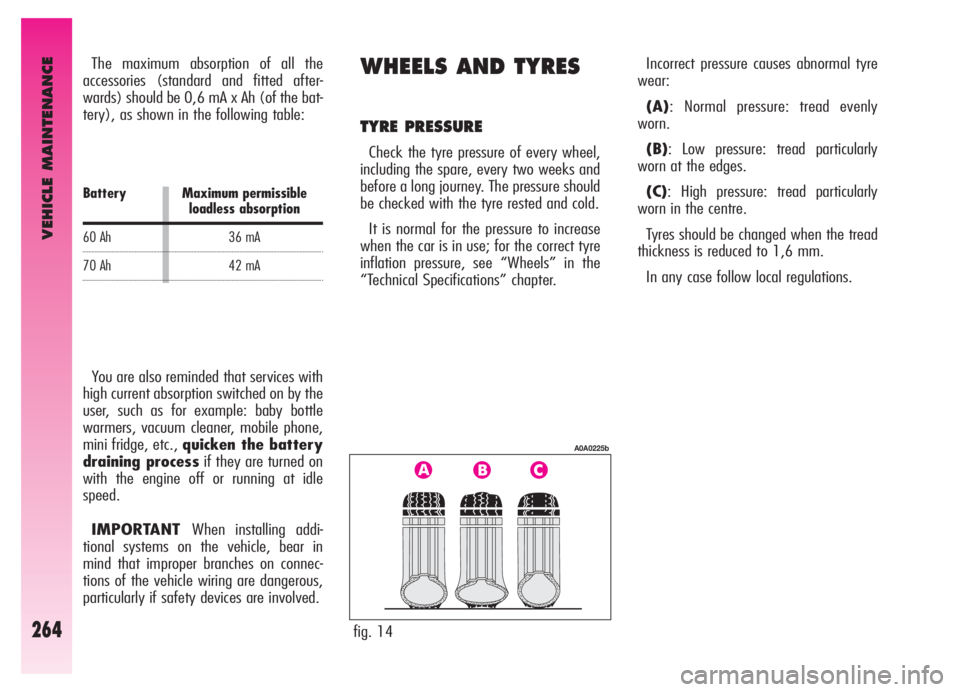
VEHICLE MAINTENANCE
264
Incorrect pressure causes abnormal tyre
wear:
(A): Normal pressure: tread evenly
worn.
(B): Low pressure: tread particularly
worn at the edges.
(C): High pressure: tread particularly
worn in the centre.
Tyres should be changed when the tread
thickness is reduced to 1,6 mm.
In any case follow local regulations.
You are also reminded that services with
high current absorption switched on by the
user, such as for example: baby bottle
warmers, vacuum cleaner, mobile phone,
mini fridge, etc., quicken the battery
draining processif they are turned on
with the engine off or running at idle
speed.
IMPORTANT When installing addi-
tional systems on the vehicle, bear in
mind that improper branches on connec-
tions of the vehicle wiring are dangerous,
particularly if safety devices are involved.
WHEELS AND TYRES
TYRE PRESSURE
Check the tyre pressure of every wheel,
including the spare, every two weeks and
before a long journey. The pressure should
be checked with the tyre rested and cold.
It is normal for the pressure to increase
when the car is in use; for the correct tyre
inflation pressure, see “Wheels” in the
“Technical Specifications” chapter.
Battery
60 Ah
70 AhMaximum permissible
loadless absorption
36 mA
42 mA
The maximum absorption of all the
accessories (standard and fitted after-
wards) should be 0,6 mA x Ah (of the bat-
tery), as shown in the following table:
fig. 14
A0A0225b
Page 270 of 307
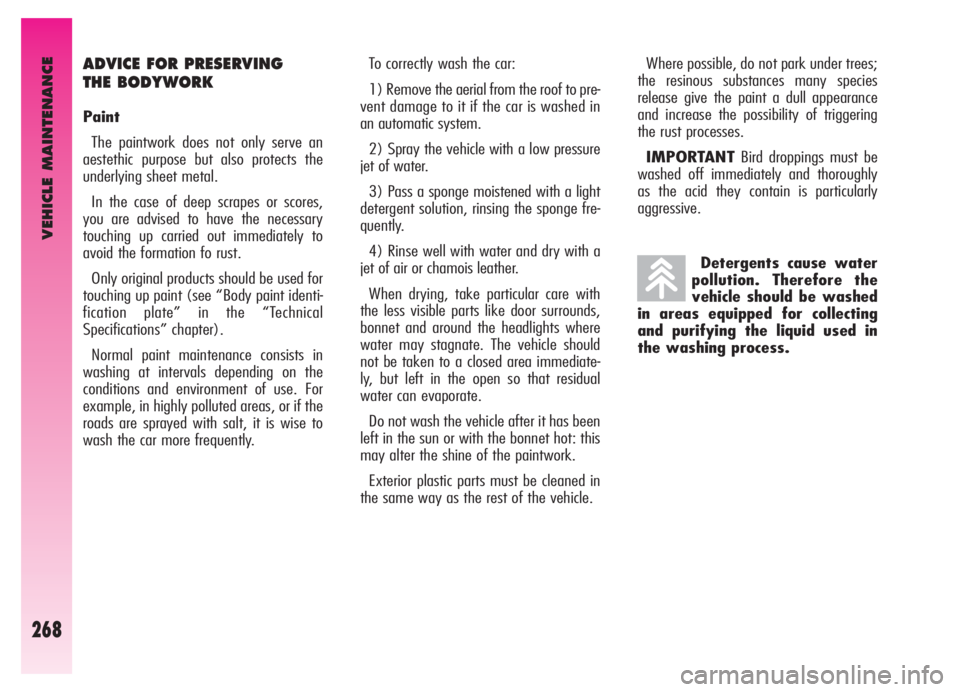
VEHICLE MAINTENANCE
268
Detergents cause water
pollution. Therefore the
vehicle should be washed
in areas equipped for collecting
and purifying the liquid used in
the washing process.Where possible, do not park under trees;
the resinous substances many species
release give the paint a dull appearance
and increase the possibility of triggering
the rust processes.
IMPORTANTBird droppings must be
washed off immediately and thoroughly
as the acid they contain is particularly
aggressive.
To correctly wash the car:
1) Remove the aerial from the roof to pre-
vent damage to it if the car is washed in
an automatic system.
2) Spray the vehicle with a low pressure
jet of water.
3) Pass a sponge moistened with a light
detergent solution, rinsing the sponge fre-
quently.
4) Rinse well with water and dry with a
jet of air or chamois leather.
When drying, take particular care with
the less visible parts like door surrounds,
bonnet and around the headlights where
water may stagnate. The vehicle should
not be taken to a closed area immediate-
ly, but left in the open so that residual
water can evaporate.
Do not wash the vehicle after it has been
left in the sun or with the bonnet hot: this
may alter the shine of the paintwork.
Exterior plastic parts must be cleaned in
the same way as the rest of the vehicle. ADVICE FOR PRESERVING
THE BODYWORK
Paint
The paintwork does not only serve an
aestethic purpose but also protects the
underlying sheet metal.
In the case of deep scrapes or scores,
you are advised to have the necessary
touching up carried out immediately to
avoid the formation fo rust.
Only original products should be used for
touching up paint (see “Body paint identi-
fication plate” in the “Technical
Specifications” chapter).
Normal paint maintenance consists in
washing at intervals depending on the
conditions and environment of use. For
example, in highly polluted areas, or if the
roads are sprayed with salt, it is wise to
wash the car more frequently.
Page 273 of 307
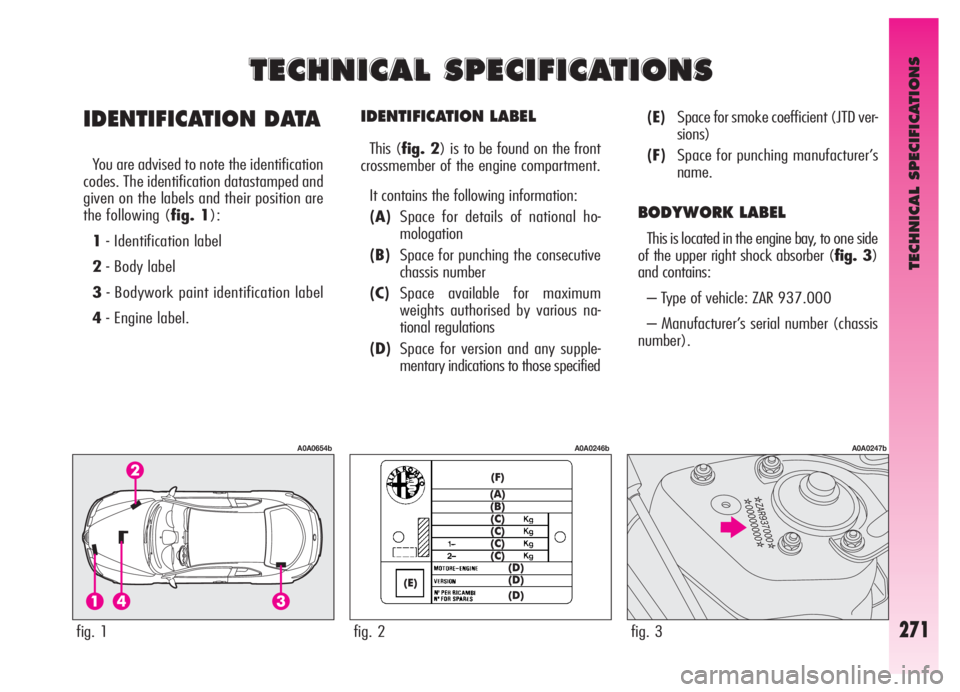
TECHNICAL SPECIFICATIONS
271
IDENTIFICATION LABEL
This (fig. 2) is to be found on the front
crossmember of the engine compartment.
It contains the following information:
(A)Space for details of national ho-
mologation
(B)Space for punching the consecutive
chassis number
(C)Space available for maximum
weights authorised by various na-
tional regulations
(D)Space for version and any supple-
mentary indications to those specified(E)Space for smoke coefficient (JTD ver-
sions)
(F)Space for punching manufacturer’s
name.
BODYWORK LABEL
This is located in the engine bay, to one side
of the upper right shock absorber (fig. 3)
and contains:
– Type of vehicle: ZAR 937.000
– Manufacturer’s serial number (chassis
number).
IDENTIFICATION DATA
You are advised to note the identification
codes. The identification datastamped and
given on the labels and their position are
the following (fig. 1):
1- Identification label
2- Body label
3- Bodywork paint identification label
4- Engine label.
T T
E E
C C
H H
N N
I I
C C
A A
L L
S S
P P
E E
C C
I I
F F
I I
C C
A A
T T
I I
O O
N N
S S
fig. 1
A0A0654b
fig. 2
A0A0246b
fig. 3
A0A0247b
Page 274 of 307
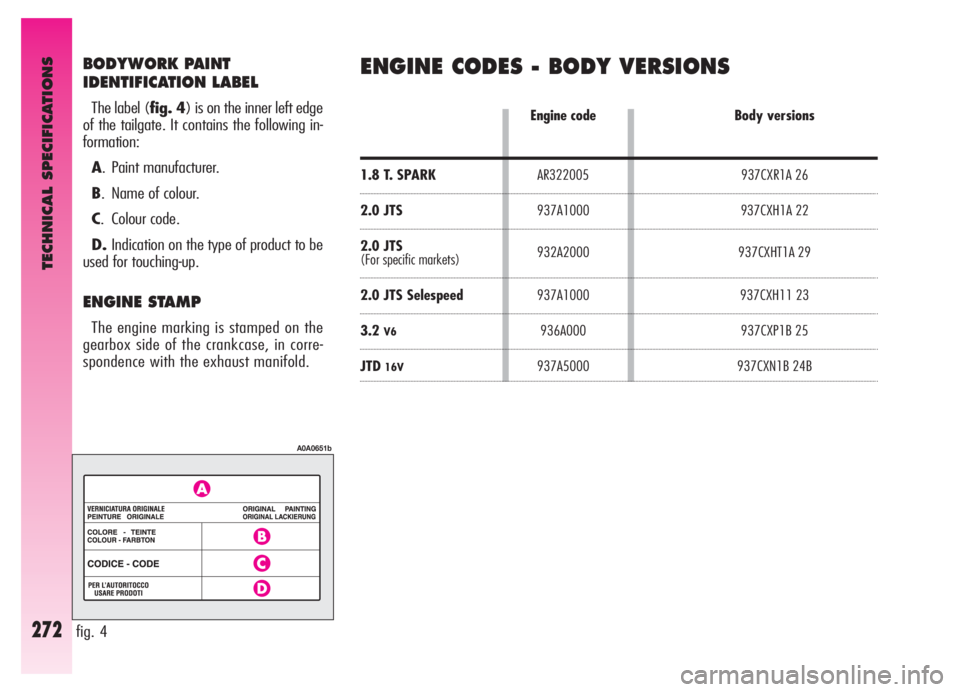
TECHNICAL SPECIFICATIONS
272
BODYWORK PAINT
IDENTIFICATION LABEL
The label (fig. 4) is on the inner left edge
of the tailgate. It contains the following in-
formation:
A. Paint manufacturer.
B. Name of colour.
C. Colour code.
D.Indication on the type of product to be
used for touching-up.
ENGINE STAMP
The engine marking is stamped on the
gearbox side of the crankcase, in corre-
spondence with the exhaust manifold.
ENGINE CODES - BODY VERSIONS
fig. 4
A0A0651b
Engine code Body versions
1.8 T. SPARKAR322005 937CXR1A 26
2.0 JTS937A1000 937CXH1A 22
2.0 JTS
932A2000 937CXHT1A 29
(For specific markets)
2.0 JTS Selespeed937A1000 937CXH11 23
3.2V6936A000 937CXP1B 25
JTD16V937A5000 937CXN1B 24B
Page 275 of 307
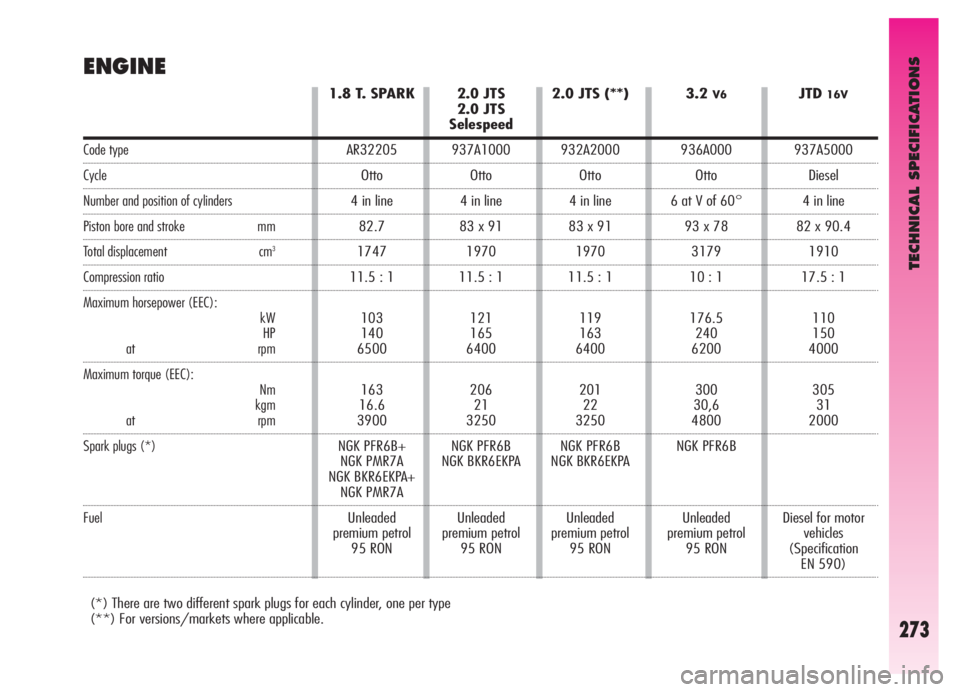
TECHNICAL SPECIFICATIONS
273
ENGINE
2.0 JTS
2.0 JTS
Selespeed
937A1000
Otto
4 in line
83 x 91
1970
11.5 : 1
121
165
6400
206
21
3250
NGK PFR6B
NGK BKR6EKPA
Unleaded
premium petrol
95 RON2.0 JTS (**)
932A2000
Otto
4 in line
83 x 91
1970
11.5 : 1
119
163
6400
201
22
3250
NGK PFR6B
NGK BKR6EKPA
Unleaded
premium petrol
95 RONJTD16V
937A5000
Diesel
4 in line
82 x 90.4
1910
17.5 : 1
110
150
4000
305
31
2000
Diesel for motor
vehicles
(Specification
EN 590) 3.2
V6
936A000
Otto
6 at V of 60°
93 x 78
3179
10 : 1
176.5
240
6200
300
30,6
4800
NGK PFR6B
Unleaded
premium petrol
95 RON
(*) There are two different spark plugs for each cylinder, one per type
(**) For versions/markets where applicable.1.8 T. SPARK
AR32205
Otto
4 in line
82.7
1747
11.5 : 1
103
140
6500
163
16.6
3900
NGK PFR6B+
NGK PMR7A
NGK BKR6EKPA+
NGK PMR7A
Unleaded
premium petrol
95 RONCode type
Cycle
Number and position of cylinders
Piston bore and stroke mm
Total displacement cm3
Compression ratio
Maximum horsepower (EEC):
kW
HP
at rpm
Maximum torque (EEC):
Nm
kgm
at rpm
Spark plugs (*)
Fuel